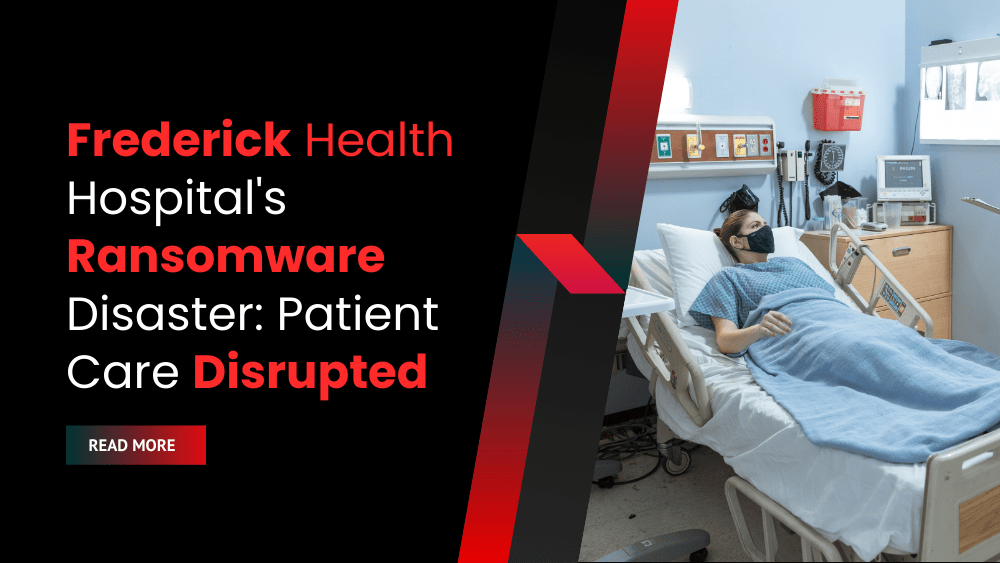On January 27, 2025, Frederick Health Hospital (FHH) became the target of a sophisticated ransomware attack, forcing the immediate shutdown of its IT infrastructure and paralyzing essential healthcare services. The incident underscores the growing cybersecurity threats facing the healthcare industry as attackers increasingly target vital systems responsible for patient care.
The breach, confirmed by third-party cybersecurity experts as ransomware, disrupted multiple hospital operations, including electronic health records (EHR), laboratory services, and emergency department communications. Although the specific ransomware variant remains unidentified, its impact on FHH was both immediate and severe, bringing modern healthcare operations to a grinding halt.
FHH’s spokesperson acknowledged the incident, stating, “Our primary concern is the safety and well-being of our patients. We are working around the clock to restore systems and resume normal operations.” The hospital has sought assistance from cybersecurity experts and law enforcement to mitigate the damage and investigate the origins of the attack.
Timeline of the Cyberattack: From Initial Detection to Systemic Collapse
The ransomware attack unfolded rapidly, highlighting the hospital’s vulnerability and lack of preparedness for such a sophisticated assault:
- January 27, 2025: FHH’s IT team detected unusual network activity, prompting an immediate emergency shutdown of critical systems to contain the threat.
- January 28, 2025: With digital systems offline, the hospital activated downtime procedures, including a transition to paper-based record-keeping for patient care.
- February 6, 2025: Cybersecurity experts confirmed that ransomware was the cause of the disruption. Law enforcement agencies, including the FBI, were notified to assist with the investigation.
- Ongoing: Partial restoration efforts are underway, but FHH has not provided a clear timeline for full recovery.
IT Infrastructure Paralysis: The Shift to Manual Healthcare Delivery
The ransomware attack crippled Frederick Health Hospital’s digital infrastructure, severely impacting healthcare delivery. With electronic systems rendered unusable, staff were forced to revert to manual processes, significantly slowing operations and increasing the risk of medical errors.
Key impacts included:
- Lab Closures: The Frederick Health Village Laboratory suspended operations, delaying diagnostic services crucial for patient care.
- Emergency Department Overload: Ambulance diversions were initiated, placing additional strain on neighboring facilities such as Meritus Medical Center, which struggled to accommodate the surge in patients.
- Prescription Delays: With electronic prescription systems offline, patients faced delays in receiving essential medications, as providers had to manually handle prescription requests.
Patient Data Breach Risks: Compliance and Privacy Implications
One of the most concerning aspects of the ransomware attack is the potential compromise of sensitive patient data. FHH is currently investigating whether hackers exfiltrated data, including:
- Personal Health Information (PHI): Medical records, Social Security numbers, and insurance details could be at risk.
- HIPAA Compliance Concerns: The Health Insurance Portability and Accountability Act (HIPAA) mandates strict data protection measures. Failure to secure patient data could result in significant regulatory penalties.
FHH has pledged to notify affected individuals as required by law. However, the hospital has faced criticism for a lack of transparency regarding the extent of the breach and the steps being taken to protect patient information.
Incident Response Strategy: Collaboration with Cybersecurity Experts
In response to the attack, FHH has mobilized a multi-faceted incident response strategy involving collaboration with cybersecurity experts and law enforcement agencies.
Key elements of the response include:
- Third-Party Cybersecurity Firms: These experts are conducting forensic analyses to identify the attack’s origins and recommend measures to mitigate vulnerabilities.
- Law Enforcement Coordination: Agencies such as the FBI and the Cybersecurity and Infrastructure Security Agency (CISA) are likely involved in the investigation.
- System Hardening: FHH plans to rebuild its IT infrastructure with enhanced security measures to prevent future attacks. This includes the adoption of advanced threat detection systems and data protection strategies.
Healthcare Sector Vulnerabilities: Lessons from the FHH Breach
The ransomware attack on FHH reflects broader trends in healthcare cybersecurity, where hospitals are increasingly targeted by cybercriminals due to the high stakes involved.
Key lessons from the incident include:
- Targeted Ransomware Campaigns: Cybercriminals view healthcare institutions as lucrative targets because of their reliance on digital systems for critical operations.
- Need for Proactive Measures: Healthcare organizations must adopt comprehensive cybersecurity frameworks that include:
- Immutable Backups: Implementing air-gapped storage solutions to protect data from encryption.
- Zero-Trust Architecture: Restricting access to sensitive systems and requiring continuous authentication.
- Employee Training: Conducting regular cybersecurity drills to mitigate phishing risks.
By learning from incidents like the FHH breach, healthcare providers can better protect their IT infrastructure and patient data.









